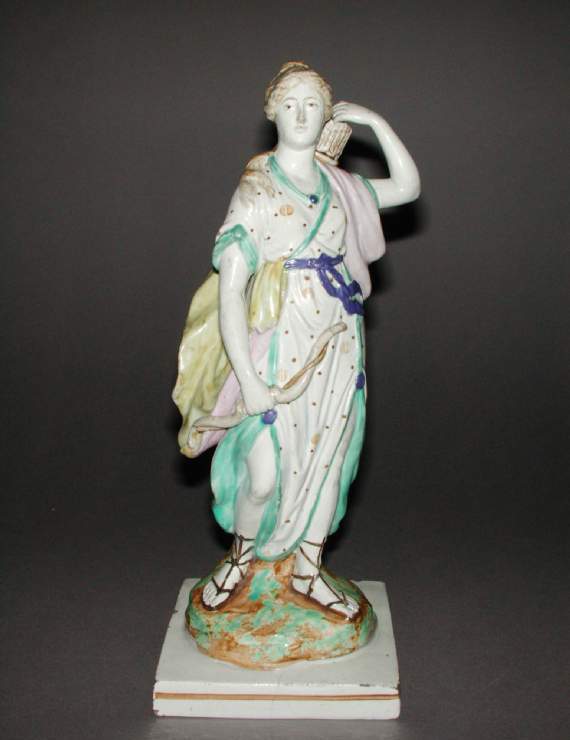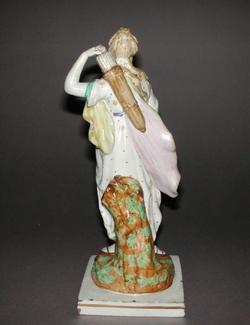Current Location: In storage
Titles
The goddess Diana
Maker(s)
Production:
Unidentified Staffordshire factory
Production:
Wood, Ralph, II
(Possibly)
Entities
Categories
Description
Lead-glazed earthenware figure of the goddess Diana painted in polychrome enamels
White earthenware, press-moulded, covered with slightly blue tinted lead-glaze and painted in blue, turquoise, green, yellow, pale orange, lilac, brown, and dark brown enamels. The shallow square base is chamfered on the inside edge and has a large central ventilation hole. Diana stands on a low mound with a tree stump at the back. She steps forward on her left foot and has her right knee relaxed. She holds a bow in her right hand and with her left is about to draw an arrow from a quiver on her back. Her brown hair is swept up into a bun at the back of her head and long tresses fall down over her shoulders. She wears a long white dress decorated pale orange circles and small brown spots, which has turquoise borders around the armholes and neck edge, and a blue sash tied at centre front. The lower part has a turquoise lining and is caught up in two places at the front by turquoise ribbons and blue brooches to reveal her elegant legs. A yellow and lilac cloak passes over her left shoulder and round her back to her right side where it is tucked into her belt. Her bare feet are clad in sandals with dark brown straps. The mound and tree stump are mottled in green, turquoise, and brown. A yellowish-brown line runs round the side of the base.
Notes
History note: Victor Benjamin Button, from whom bought for about £2 in 1905 by Dr JW.L. Glaisher, FRS, Trinity College, Cambridge
Legal notes
Dr J.W.L. Glaisher Bequest
Measurements and weight
Height: 28.8 cm
Acquisition and important dates
Method of acquisition: Bequeathed
(1928-12-07)
by
Glaisher, J. W. L., Dr
Dating
19th Century, Early
George III
Circa
1800
-
1820
Note
Diana was the goddess of hunting in Roman mythology. She was the equivalent of the Greek goddess, Artemis. Although more static, and transposed, the figure might have been inspired by a small-scale reproduction of the famous marble Diane Chasseresse now in the Louvre.
School or Style
Neoclassical
People, subjects and objects depicted
Components of the work
Decoration
composed of
enamel
( blue, turquoise, green, yellow, pale orange, lilac, brown, and dark brown)
Base
Depth 11 cm
Width 11 cm
Surfaced
Materials used in production
white
Earthenware
Lead-glaze
Techniques used in production
Press-moulding
: White earthenware, press-moulded, covered with slightly blue tinted lead-glaze and painted in blue, turquoise, green, yellow, pale orange, lilac, brown, and dark brown enamels
References and bibliographic entries
Identification numbers
Accession number: C.892-1928
Primary reference Number: 76301
Old object number: 2335
Stable URI
Audit data
Created: Saturday 6 August 2011
Updated: Tuesday 30 April 2024
Last processed: Tuesday 15 July 2025
Associated departments & institutions
Owner or interested party:
The Fitzwilliam Museum
Associated department:
Applied Arts





